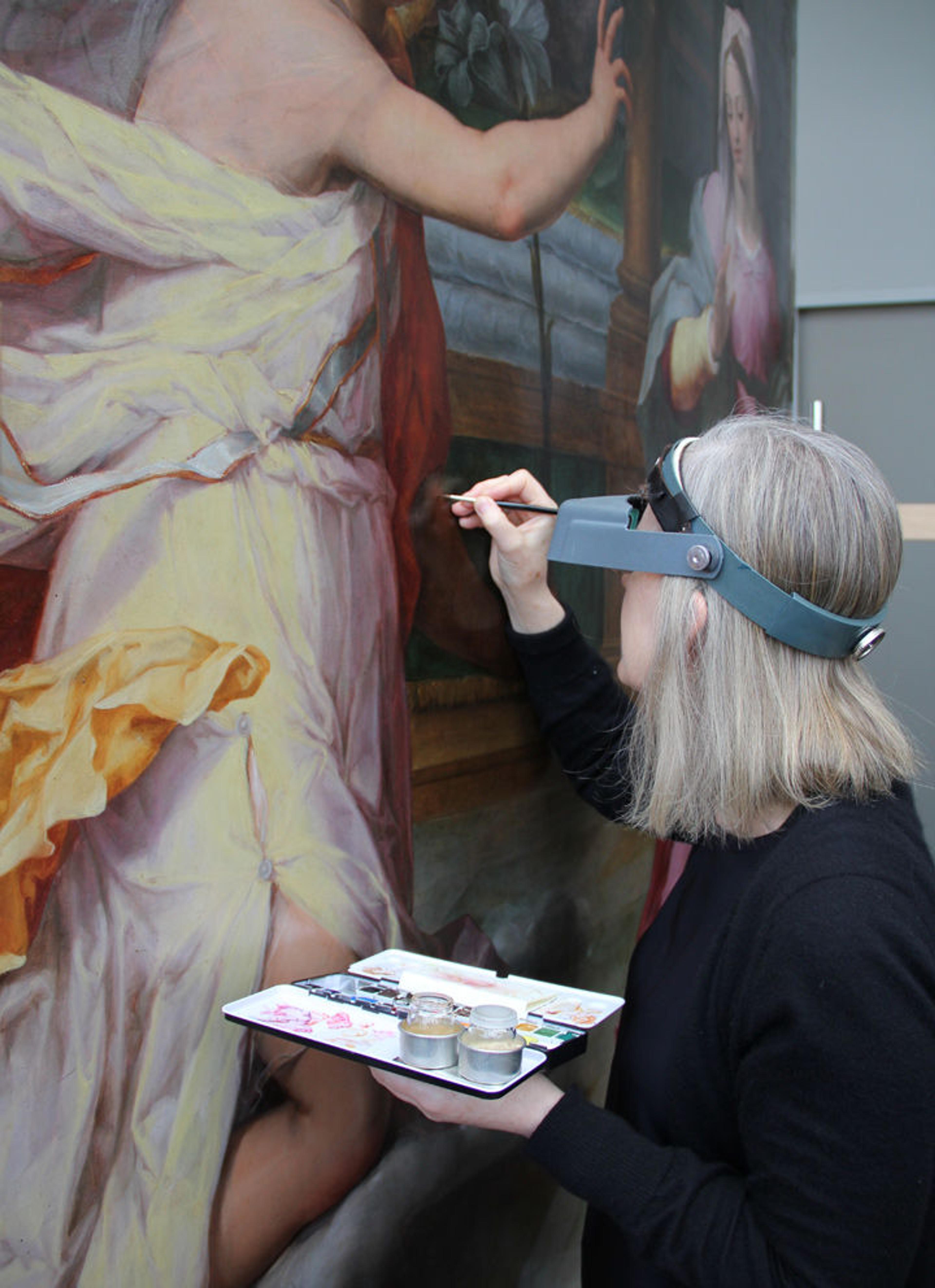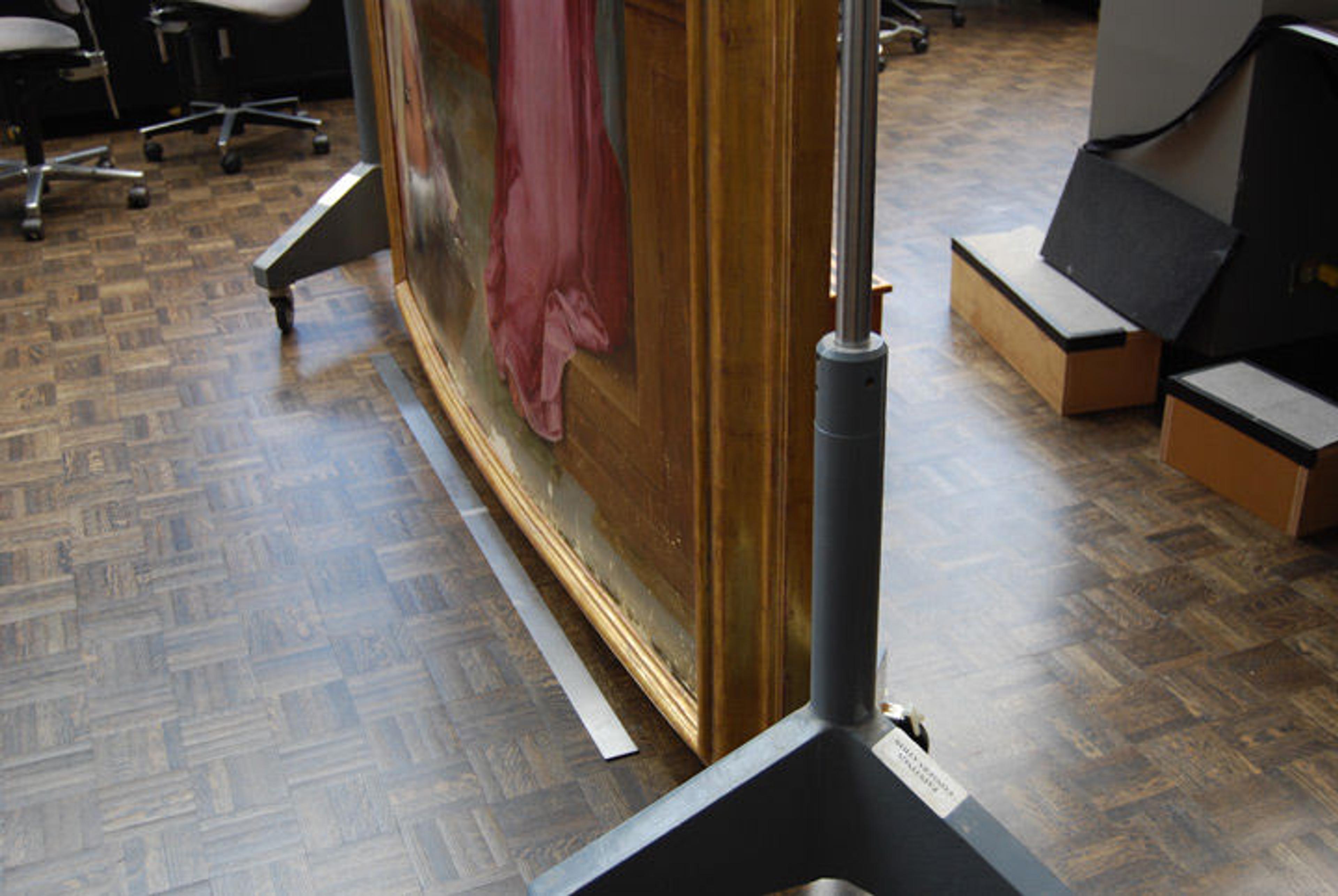
Conservator Charlotte Hale in-painting Peter Candid's The Annunciation. Photo by the author
«In part two, we discussed the repair of the splits and cracks in Peter Candid's The Annunciation and the construction of a new secondary support for the panel. With the structural work completed, it was time to return to the restoration of the paint surface. I mentioned in part one that the painting had come into the studios of the Department of Paintings Conservation with a thick, obscuring varnish and heavy overpaint disguising areas of loss (see before). The varnish and overpaint were removed prior to the structural treatment (see during).»
The panel came to The Met in 2011 with a thick varnish and heavy overpaint (before) that was removed before the restoration of the paint surface (during). Peter Candid (Pieter de Witte, Pietro Candido) (Netherlandish, ca. 1548–1628). The Annunciation (before and during conservation), ca. 1585. Oil on wood, 91 1/4 x 68 1/4 in. (231.8 x 173.3 cm). The Metropolitan Museum of Art, New York, Gift of Fabrizio Moretti, in honor of Keith Christiansen, 2011 (2011.75)
This cleaning revealed areas throughout the painting where there were conspicuous losses to the paint layers. While these occur at cracks and splits in the panel support, it is also normal, in a painting that is over 400 years old, to find scratches, scrapes, and impacts that occur over time. Additionally, some thinner passages of paint had minute losses where paint had flaked off in the past. Following the application of a thin varnish coating to isolate restoration from the original surface, the deeper losses were carefully filled with white gesso and made level to the paint surface.
The panel was then returned to the main studio, where Conservator Charlotte Hale finished the restoration of the surface. Carefully matching the surrounding color, Charlotte in-painted the many tiny losses, bringing new life and legibility to the painting. In-painting requires precise color matching using a paint medium that can be easily removed if necessary because reversibility is an important tenet in conservation. Thin layers of varnish were applied to re-saturate the paint layers and bring luster and vibrancy, as was originally intended. The end result of Charlotte's work with the in-painting and final varnish complete brought the vibrancy and richness of the original colors back to the painting (see after).
The Annunciation during and after conservation. With the obscuring varnish and the heavy overpaint removed from the panel (during), Charlotte completed the restoration of the paint surface (after).
Since Charlotte's work would be time-consuming, we thought this would be the perfect opportunity to gather some important data. There are a handful of projects around the world in which scientists are gathering information on the micromovements of panel paintings, which occur when the surrounding relative humidity fluctuates. This information is being carefully studied to understand not only the amount of movement that is occurring, but also to see if stress levels within a panel painting can be measured and understood. To this end, Research Scientist Paolo Dionisi Vici attached a number of transducers to the back of The Annunciation panel that measured every tiny movement the panel made. This data was saved to a data logger, which could then be gathered remotely using BlueTooth technology. While this ongoing study is not the first of its kind, it certainly is the first in the United States.

The transducers mounted on the back of the panel measuring micromovements in the painting. Photo by the author
The final part that we needed to carefully consider was the framing of the painting. When paintings are flat, they can be easily fit into a frame and held securely. Often, however, panel paintings develop a convex curvature (curving outward) over time. If the curve is quite deep, as is the case in this panel, a flat frame would actually accentuate the curvature of the panel. To avoid this, we decided to have a curved frame made for the painting that would contact it on all four sides, which would help visually "flatten" the image. The best way to understand this is to come see the painting for yourself in gallery 609. Stand back from the painting, and then look at it straight on. You'll notice that the panel appears flat. The visual references within the frame that indicate the curvature of the panel are reduced. It is only when approaching the painting from the side or up close that a sense of its curvature becomes apparent.

The curvature of the panel becomes apparent when seen from a side angle. A curved frame helps to visually minimize this curve. Photo by the author
With a new frame on the painting, The Annunciation was ready to be hung in the galleries.

Technicians John Mckanna and Rachel Robinson and riggers Raouf Ameerally and Derrick Williams hang The Annunciation. Photo by the author
Visit The Met to view this painting in the galleries of the Department of European Paintings and see the results in person. We would love to hear what you think.

Peter Candid's The Annunciation in gallery 609 alongside Santi di Tito's Madonna and Child with the Infant Saint John the Baptist and Mirabello Cavalori's portrait of a Knight of Malta, probably Fra Jacopo Salviati
Related Link
See all blog posts related to the conservation of Peter Candid's The Annunciation.